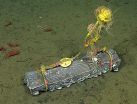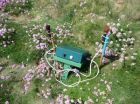(Press-News.org) New research on the skulls of red pandas and giant pandas provides further explanation as to why the two species—which are not closely related but dine on the same food, bamboo, in the same geographic area—are able to coexist. Using high-resolution imaging and biting simulations, scientists at the American Museum of Natural History and the University of Málaga in Spain found that the skulls of the two panda species not only are distantly related but also have structural differences related to the way the animals chew. These substantial differences reflect distinct bamboo feeding preferences, with red pandas foraging on softer parts of the plant and giant pandas seeking out the tougher stems. The findings are published in the journal Biology Letters.
"Scientists have been studying the differences between red pandas and giant pandas for a long time because there's a basic principle in ecology that says if two species of an organism utilize the same resources, they cannot live in the same space. There's too much competition," said Z. Jack Tseng, a Frick Postdoctoral Fellow in the Museum's Division of Paleontology and the corresponding author on the new study. "This research contributes to the body of work showing how the pandas co-exist. We've found that fundamentally, based on the structure of their skulls, they cannot eat the same things."
The red (Ailurus fulgens) and giant (Ailuropoda melanoleuca) pandas are mammalian carnivores separated from each other by about 40 million years of evolution. The red panda is most closely related to animals like raccoons and weasels and weighs about 10 pounds. The giant panda is a member of the bear family, and it is much larger, weighing about 220 pounds. Their geographic ranges overlap in southern China, and both animals have independently adapted to a diet consisting mainly of the same bamboo species.
The researchers used x-ray computed tomography (CT) to create high-resolution, three-dimensional models of the pandas' skulls and teeth. Based on these data, they built a series of computer-generated biting simulations to study the skulls' biomechanics. They found that although the skulls have some broad similarities—they both are robust and versatile and can accommodate a wide variety of chewing—there are some distinct differences.
The skull of the red panda is better at distributing mechanical stress during chewing than the skull of the giant panda. But the giant panda has a stronger skull that can withstand greater forces that are more concentrated and could be more damaging, even after accounting for the size differences between the two species.
"These differences tie into the way that the species actually process bamboo," Tseng said. "The giant panda is a less-refined eater: it does a lot of chomping and swallowing. Their skulls are stronger overall, so the peak biting stresses are lower, meaning that they can eat harder and larger pieces of bamboo. The red panda has a weaker skull but it's better at distributing stresses, allowing it to chew longer and break down soft bamboo leaves more thoroughly before they swallow them."
These links between dietary preference and skull performance provide an engineering basis for explaining how the co-existence of the two panda species is possible, the authors say.
INFORMATION:
This work was supported by the Ministry of Economy and Competitiveness (MINECO) of Spain and the Museum's Frick Postdoctoral Fellowship.
Other authors include Borja Figueirido, Francisco J. Serrano-Alarcón, Alberto Martón-Serra, and Juan F. Pastor, all from the University of Málaga.
Scientific paper (subscription required): http://rsbl.royalsocietypublishing.org/content/10/4/20140196.full
Biting simulations of the red panda and giant panda skulls can be viewed at: https://www.youtube.com/watch?v=P7sKhJHI4Ag
Skulls of red and giant pandas provide insight into coexistence
Biting simulations show key differences in panda skulls, link to dietary preferences
2014-04-09
ELSE PRESS RELEASES FROM THIS DATE:
Oyster aquaculture could significantly improve Potomac River estuary water quality
2014-04-09
Oyster aquaculture in the Potomac River estuary could result in significant improvements to water quality, according to a new NOAA and U.S. Geological Survey study published in the journal Aquatic Geochemistry.
All of the nitrogen currently polluting the Potomac River estuary could be removed if 40 percent of its river bed were used for shellfish cultivation, according to the joint study. The researchers determined that a combination of aquaculture and restored oyster reefs may provide even larger overall ecosystem benefits. Oysters, who feed by filtering, can clean an ...
Genome sequencing of MRSA infection predicts disease severity
2014-04-09
April 9, 2014 –The spread of the antibiotic-resistant pathogen MRSA (methicillin-resistant Staphylococcus aureus) remains a concerning public health problem, especially among doctors trying to determine appropriate treatment options for infected patients. Bacterial pathogens, such as MRSA, cause disease in part due to toxicity, or the bacterium's ability to damage a host's tissue. In a study published online today in Genome Research, researchers used the genome sequence of MRSA to predict which isolates were highly toxic, thus potentially personalizing the treatment of ...
Farming for improved ecosystem services seen as economically feasible
2014-04-09
By changing row-crop management practices in economically and environmentally stable ways, US farms could contribute to improved water quality, biological diversity, pest suppression, and soil fertility while helping to stabilize the climate, according to an article in the May issue of BioScience. The article, based on research conducted over 25 years at the Kellogg Biological Station in southwest Michigan, further reports that Midwest farmers, especially those with large farms, appear willing to change their farming practices to provide these ecosystem services in exchange ...
DNA data could help doctors treat MRSA shows new study
2014-04-09
A team of scientists led by the University of Bath has developed a new technique to predict the toxicity of an MRSA infection from its DNA sequence. With the MRSA superbug an increasing problem in hospitals and communities, this new technique could soon help clinicians better decide the best course of treatment for infections.
Bacterial pathogens, such as MRSA, cause disease in part due to their toxicity, or the bacterium's ability to damage a host's tissue. In a study published online today in Genome Research, researchers used the genome sequence of MRSA to predict toxicity ...
Stressful environments genetically affect African-American boys
2014-04-09
PRINCETON, N.J.—Stressful upbringings can leave imprints on the genes of children as young as age 9, according to a study led by Princeton University and Pennsylvania State University researchers. Such chronic stress during youth leads to physiological weathering similar to aging.
A study of 40 9-year-old black boys, published in the Proceedings of the National Academy of Sciences, shows that those who grow up in disadvantaged environments have shorter telomeres — DNA sequences that generally shrink with age — than their advantaged peers. The researchers also report ...
Bone marrow stem cells show promise in stroke treatment, UCI team finds
2014-04-09
Irvine, Calif., April 9, 2014 — Stem cells culled from bone marrow may prove beneficial in stroke recovery, scientists at UC Irvine's Sue & Bill Gross Stem Cell Research Center have learned.
In an analysis of published research, neurologist Dr. Steven Cramer and biomedical engineer Weian Zhao identified 46 studies that examined the use of mesenchymal stromal cells – a type of multipotent adult stem cells mostly processed from bone marrow – in animal models of stroke. They found MSCs to be significantly better than control therapy in 44 of the studies.
Importantly, the ...
See what a child will look like using automated age-progression software
2014-04-09
It's a guessing game parents like to ponder: What will my child look like when she grows up? A computer could now answer the question in less than a minute.
University of Washington researchers have developed software that automatically generates images of a young child's face as it ages through a lifetime. The technique is the first fully automated approach for aging babies to adults that works with variable lighting, expressions and poses.
"Aging photos of very young children from a single photo is considered the most difficult of all scenarios, so we wanted to focus ...
Sunken logs create new worlds for seafloor animals
2014-04-09
MOSS LANDING, CA — When it comes to food, most of the deep sea is a desert. Many seafloor animals feed on marine snow—the organic remnants of algae and animals that live in the sunlit surface waters, far above. However, marine snow only falls as a light dusting and doesn't have much nutritional value. Thus, any other sources of food that reach the deep sea provide a temporary feast. Even bits of dead wood, waterlogged enough to sink, can support thriving communities of specialized animals. A new paper by biologists at the National Evolutionary Synthesis Center and the Monterey ...
Scientists reconstruct ancient impact that dwarfs dinosaur-extinction blast
2014-04-09
WASHINGTON, D.C. -- Picture this: A massive asteroid almost as wide as Rhode Island and about three to five times larger than the rock thought to have wiped out the dinosaurs slams into Earth. The collision punches a crater into the planet's crust that's nearly 500 kilometers (about 300 miles) across: greater than the distance from Washington, D.C. to New York City, and up to two and a half times larger in diameter than the hole formed by the dinosaur-killing asteroid. Seismic waves bigger than any recorded earthquakes shake the planet for about half an hour at any one ...
Counting the invisible by sound -- a new approach to estimate seabird populations
2014-04-09
AUDIO:
This is a typical one minute recording of an active Cory's Shearwater colony on the island of Corvo in the North Atlantic Ocean, June 2011.
Click here for more information.
Seabirds nest in places that are inaccessible for most humans - vertical cliffs and remote islands surrounded by raging waves. Worse still, many seabirds lay their eggs in burrows or cavities where they are protected from inclement weather and invisible for researchers. Hidden under rocks or in burrows ...
LAST 30 PRESS RELEASES:
Colliding galaxies create the brightest, fastest growing black holes at their center
New BrainHealth research reveals tradeoffs on sleep with cannabis use for chronic pain
Aging-US now on ResearchGate, enhancing visibility for authors and readers
'Molecular glue' stabilizes protein that inhibits development of non-small cell lung cancer
Mount Sinai Health System is recognized in 2025 Chime Digital Health Most Wired survey
From prey to predator: How carnivores spread beneficial fungi
Menopause symptoms may be frequent and have negative effects, according to female endurance athletes
US Congressmembers’ responses on X to mass shooting events differ along party lines
KAIST-UEL team develops “origami” airless wheel to explore lunar caves
Individual genetic differences render some therapies ineffective
Engineering dendritic cells boosts cancer immunotherapy
Sophisticated neuroimaging reveals PTSD in WTC responders is linked to measurable physical changes in brain structure
Health policy experts identify promising strategies for providing health care to homeless people
Study explores role of neutrophils in canine atopic dermatitis
Mayo Clinic researchers develop AI-ECG model to diagnose liver disease earlier
Heavy menstruation common among teenage girls – questionnaire reveals risk of iron deficiency
New study explores why open water swimming feels so powerful for midlife women
In echo of Jurassic Park, mosquitoes capture entire ecosystems in their blood meals
Marty Cooper, Illinois Tech Alumnus and ‘Father of the Cell Phone,’ Receives 2025 Marconi Society Lifetime Achievement Award
How to reduce the risk of lymphedema
NEJM Evidence and CIDRAP announce Public Health Alerts
New fossil study illuminates on the evolutionary success of frogs
Patient-specific human liver model to understand disease mechanisms
Confused by the doctor's questionnaire? U of A study suggests it's common
How do brains stay stable, and when might a dose of flexibility be helpful?
mRNA revitalizes aging immune systems—the liver as a fountain of youth
Rural-urban differences in the prevalence of chronic pain among adult cancer survivors
Food insecurity, burnout, and social isolation among resident and fellow physicians
How do spinal cord injuries heal?
Detailed cell map unlocks secrets of how reproductive organs form
[Press-News.org] Skulls of red and giant pandas provide insight into coexistenceBiting simulations show key differences in panda skulls, link to dietary preferences






